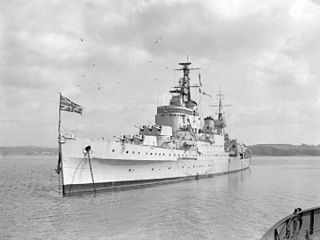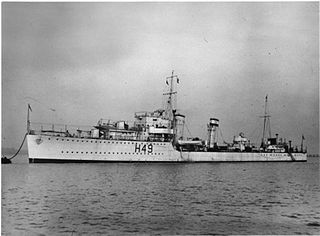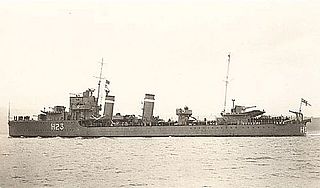
HMS Newcastle was a member of the Southampton subclass of the Town-class light cruiser of the Royal Navy.

HMS Ajax was a Leander-class light cruiser which served with the Royal Navy during World War II. She became famous for her part in the Battle of the River Plate, the Battle of Crete, the Battle of Malta and as a supply escort in the siege of Tobruk. This ship was the eighth in the Royal Navy to bear the name. In February 1942, she was adopted by the civil community of Halifax, West Yorkshire.

HMS Duncan was a D-class destroyer leader built for the Royal Navy in the early 1930s. The ship was initially assigned to the Mediterranean Fleet before she was transferred to the China Station in early 1935 where she remained until mid-1939. Duncan returned to the Mediterranean Fleet just after World War II began in September 1939. She was transferred to the Home Fleet in December 1939, although she was badly damaged in a collision the following month, and required repairs that lasted until July 1940. The ship joined Force H at Gibraltar in October, escorting the larger ships and various convoys until March 1941 when she was transferred to West Africa for convoy escort duties for a few months. Duncan rejoined the 13th Destroyer Flotilla at Gibraltar in July and escorted several convoys to Malta during the rest of the year. After a refit, she briefly returned to the 13th Destroyer Flotilla before joining the Eastern Fleet in the Indian Ocean to participate in Operation Ironclad in May 1942. The ship was recalled home to be converted into an escort destroyer in late 1942.

HMS Euryalus was a Dido-class cruiser of the Royal Navy. She was laid down at Chatham Dockyard on 21 October 1937, launched on 6 June 1939, and commissioned 30 June 1941. Euryalus was the last cruiser built at the dockyard.

HMS Rotherham was an R-class destroyer of the British Royal Navy during the Second World War, named after Captain Edward Rotheram, who commanded HMS Royal Sovereign during at the Battle of Trafalgar in 1805. Rotherham was completed in 1942 and equipped as a flotilla leader, having slightly reduced armament to allow for the increased complement and working space required. Decommissioned in 1945, the ship was sold to India in 1948, serving as INS Rajput (D141) until 1976, when she was scrapped.

HMS Punjabi was a Tribal-class destroyer of the Royal Navy that saw service in the Second World War, being sunk in a collision with the battleship King George V. She has been the only ship of the Royal Navy to bear the name "Punjabi" which, in common with the other ships of the Tribal class, was named after various ethnic groups of the world, mainly those of the British Empire.

HMS Tartar was a Tribal-class destroyer of the Royal Navy that saw service in most of the naval theatres of World War II. She had an eventful career, eventually receiving the nickname 'Lucky Tartar' due to her numerous escapes from dangerous situations. She was one of only four from the sixteen Royal Navy-operated Tribal-class destroyers to survive the war.

HMS Ursa was a U-class destroyer of the Royal Navy that saw service during the Second World War. She was later converted into a Type 15 fast anti-submarine frigate, with the new pennant number F200.

HMS Vigilant was a V-class destroyer of the British Royal Navy that saw service during World War II.

HMS Wizard was a W-class destroyer of the British Royal Navy that saw service during World War II.

HMS Diana was a D-class destroyer of the Royal Navy. Ordered in 1931, the ship was constructed by Palmers Shipbuilding and Iron Company, and entered naval service in 1932. Diana was initially assigned to the Mediterranean Fleet before she was transferred to the China Station in early 1935. She was temporarily deployed in the Red Sea during late 1935 during the Abyssinia Crisis, before returning to her duty station where she remained until mid-1939. Diana was transferred back to the Mediterranean Fleet just before the Second World War began in September 1939. She served with the Home Fleet during the Norwegian Campaign. The ship was transferred to the Royal Canadian Navy in 1940 and renamed HMCS Margaree. She served for just over a month with the Canadians before being sunk in a collision with a large freighter she was escorting on 22 October 1940.

HMS Echo was an E-class destroyer of the British Royal Navy that saw service in the Atlantic, Arctic and Mediterranean theatres during World War II, before being transferred to the Royal Hellenic Navy in 1944, and renamed Navarinon, until scrapped in 1956.

HMS Eclipse was an E-class destroyer of the Royal Navy that saw service in the Atlantic, Arctic, and Mediterranean theatres during World War II, until sunk by a mine in the Aegean Sea on 24 October 1943.

HMS Opportune was an O-class destroyer of the Royal Navy. She was ordered from John I. Thornycroft & Company, Woolston on 3 September 1939 for the 1st Emergency Flotilla. She was commissioned on 14 August 1942. She was the second Royal Navy ship borne Opportune.

HMS Kempenfelt was a W-class destroyer flotilla leader of the Royal Navy that served in the Second World War. She was the second destroyer of her name to have served in the war; the first Kempenfelt was transferred to the Royal Canadian Navy in October 1939 and renamed HMCS Assiniboine.

HMS Whelp was one of eight W-class destroyers built for the Royal Navy during the Second World War. Completed in 1944, the ship spent most of the war assigned to the Eastern and Pacific Fleets. She screened British aircraft carriers as their aircraft attacked targets in the Japanese-occupied Nicobar Islands, the Dutch East Indies, Formosa and near Okinawa. Whelp was present at the Japanese surrender in Tokyo Bay in 1945 and later in Hong Kong. She was paid off in January 1946 and went into reserve.

HMS Wishart (D67) was a Modified W-class destroyer of the British Royal Navy that saw service in World War II. She spent most of her wartime career based at Gibraltar, engaged in convoy defence, but also served in various naval and military operations in the Mediterranean Sea.

The second HMS Wivern, was a Modified W-class destroyer of the British Royal Navy that saw service in World War II.

The destroyer HNLMS Tjerk Hiddes was a British built, Dutch warship of World War II. She was laid down on 22 May 1940 as a British N-class destroyer and launched on 25 June 1941 as HMS Nonpareil, but on 27 May 1942, she was transferred to the Royal Dutch Navy. The ship was commissioned in 1942 as HNLMS Tjerk Hiddes, named after the 17th century Dutch admiral, Tjerk Hiddes de Vries. Much of her war service was with the Royal Navy and United States Navy in the Indian Ocean and Australia, under the command of W. J. Kruys. Following the war, the destroyer was sold to Indonesia and renamed RI Gadjah Mada. She was scrapped in 1961.

HMS Obedient was an O-class destroyer of the Royal Navy. She was built by William Denny and Brothers of Dumbarton, between 1940 and 1942. During Warship Week in 1942 she was adopted by the civil community of Lymington, United Kingdom. She was scrapped in 1962.




















